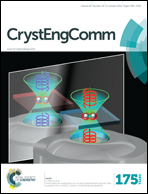Peculiarities of styryl dyes of the benzoselenazole series crystal packings and their influence on solid phase [2 + 2] photocycloaddition reaction with single crystal retention†
Abstract
New styryl dyes of the 2-benzoselenazole series which contain iodide, triiodide, and tosylate anions were synthesized. Crystals of these compounds were grown in different crystal forms – solvent free and hydroquinone, benzene or ethyl acetate solvated ones. X-ray structural studies of the crystals shows that those containing tosylate and triiodide anions form the centrosymmetrically related stacking motif, typical for styryl dye cations and favorable for [2 + 2] photocycloaddition (PCA) reactions. This reaction takes place in crystals with tosylate anions as a single crystal-to-single crystal process. On the contrary, in the triiodide dye crystals, the PCA reaction is lacking, probably due to a weak directional interaction of the selenium atoms with the anions. The iodide dye crystals demonstrate non-typical packing for styryl dyes and manifest as a two-dimensional close packing motif of the cations which is unfavorable for cycloaddition.
![Graphical abstract: Peculiarities of styryl dyes of the benzoselenazole series crystal packings and their influence on solid phase [2 + 2] photocycloaddition reaction with single crystal retention](/en/Image/Get?imageInfo.ImageType=GA&imageInfo.ImageIdentifier.ManuscriptID=C6CE01426G&imageInfo.ImageIdentifier.Year=2016)

 Please wait while we load your content...
Please wait while we load your content...